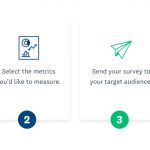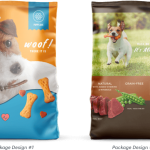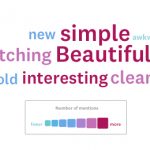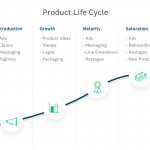Product packaging testing: How to find the best packaging for your product
Product packaging is a powerful driver of purchasing behavior. Four in five people have tried a new product just because they liked its packaging, and 1 in 2 have switched brands because they liked the new brand’s packaging better.
If you’re designing the packaging for a new product or a rebranding, you probably want to know how customers will react to your packaging before you invest in a final design. With packaging testing, you can gauge consumer sentiment and choose the right packaging design for your product.
Packaging testing gives your target audience several packaging designs and asks them to provide feedback on each one. Which is the most appealing? The most likely to get someone to buy?
Let’s take a closer look at why testing product packaging is important, what goes into an effective packaging test, and the best ways to act on the feedback you get from respondents.
Use testing to find the best product packaging design
Your packaging design differentiates your product from your competitors’ and communicates your product’s unique value to people browsing a store shelf or a website. By testing potential packaging designs before settling on one, you can pick the design that does these two things best, according to the people who’ll actually be buying your product.
When you test your product packaging, you enter the next phase of the design process with 4 major advantages:
- You have the data to back up your choice. It’s hard for other people to argue against your hard numbers. Testing proves which packaging design resonates most with your target audience, which helps you pick a design and persuade coworkers to get behind that choice.
- You know how to improve your existing designs. Your winning packaging design might not be perfect. Turn to constructive feedback from your audience to make your winning design even better.
- You know how different groups see your design. By filtering your responses, you can see how different groups (age, gender, location, etc.) feel about your packaging designs.
- Your team can make fast decisions. By frequently collecting data through agile market research, your business can react more quickly to market changes. By running your own tests, your team can make great decisions without relying on insights organizations.
Let us do the heavy lifting
We’ll test your packages on our survey panel and provide the insights you need to pick one with confidence!
4 key steps to effective packaging testing
Now that you know why it’s important to test your packaging designs before settling on one, you’re ready to start putting together your survey. Here are the 4 key steps you’ll need to follow:

Select your stimuli
While you can test any packaging design you want, it’s best to choose stimuli that you’re fairly confident in based on the reactions from people who’ve already seen the options. To avoid skewing your survey results, choose designs in a similar stage of development. If you’re testing a finished design against one you’re still fleshing out, you already know which one will win. Present your options in a standard format, like the one below, to keep the competition fair.

To make the testing process more manageable for you and your respondents, limit the number of stimuli in your survey. The total number of stimuli you should include in your test depends on whether you plan to use a monadic survey design or a sequential monadic survey design.
A monadic survey design divides up your respondent pool and presents each respondent with a survey asking for feedback on a single stimulus. When you’ve gathered enough feedback on each stimulus, you can pick a winning design by pooling the feedback from all your respondents.
Here’s an example of a product packaging test with a monadic design.
This survey design lets you ask more questions about each stimulus. It’s also more likely to result in a relatively short questionnaire, which benefits the quality of your feedback and your survey’s completion rate. However, since you’re only showing each respondent one stimulus, you’ll need to target a larger audience. This can prove costly and it might not be feasible.
A sequential monadic survey design presents every respondent with the same survey asking for feedback on multiple stimuli. Once you’ve collected responses from a statistically significant number of respondents, you can pick a winning design by looking at the most common reactions to the stimuli.
Learn more about building a sequential monadic test for product packaging.
This type of design lets you target a smaller audience than a monadic design, which makes it more cost-effective and feasible. However, if you want to keep your survey to a manageable length, you won’t be able to ask as many questions about each stimulus.
Learn more about the pros and cons of each design, and how you can set them up in SurveyMonkey.
Pick metrics to measure
What makes for good packaging design? The metrics you measure will help you decide.
The questions you ask in your packaging testing survey can be as specific as you’d like. If you want to know whether a design stands out on the shelves, for example, you might ask about visibility, aesthetics, and ease of finding in specific. Here are some key metrics you might want to include:
- Appeal: Is your product packaging enticing to potential customers?
- Ease of finding: How easy is it to spot your design on a shelf or website?
- Purchase intent: Will your packaging motivate people to buy your product?
- Quality: Does your product packaging convey quality?
- Relevance: Does your packaging reflect your audience’s needs and wants?
- Uniqueness: Is your brand’s packaging different from other brands’?
The relative value of each metric you measure depends on your goals for the design. If you want a packaging design that will really drive sales, purchase intent may be the most important metric for you. If your main goal is to differentiate your product in a highly competitive market, you’ll likely place more importance on the uniqueness of the design.
We suggest using the Likert scale to test your metrics. This scale is simple and intuitive for respondents, offers consistent choices, and makes it easy for you to analyze results. If you choose this scale, your questions can follow the formula, “How (metric) is the design?” where your answer choices range from “Extremely (metric)” to “Not at all (metric).”
For example, here’s how the question might look if our metric is purchase intent:
How likely are you to purchase the product based on the packaging design?
- Extremely likely
- Very likely
- Somewhat likely
- Not so likely
- Not at all likely
Sometimes, people respond similarly to every design in your test and don’t make it clear which design they like best. Resolve this issue by including a forced-answer question at the end of the survey that asks respondents to choose their favorite design from all the options. This question will also help you rank the importance of each metric to the overall likeability of your designs. For example, if respondents consistently choose the most unique design as their favorite, you can assume uniqueness is a key value driver for your target market.
You might also want to include screener, category, and demographic questions in your survey. These questions tell you more about the people you’re collecting feedback from and let you segment your results by group. Learn about demographic questions in our comprehensive resource for concept testing.
Want help from market research pros? Looking for ways to refine your skills?
These resources might be just what you’re looking for!
SurveyMonkey expert solutions for packaging design analysis: Quickly test your package design concepts with expert methodology, a trusted online panel, and AI-Powered Insights.
Ultimate guide to running market research: This resource has everything you need to run market research, from planning your study to taking action!
Packaging testing survey template: This expert-certified survey template can help you brainstorm your questions. You can also use it and edit it however you’d like.
SurveyMonkey Audience: Our global consumer panel allows you to survey people in more than 130 countries.
Market Research Services: From survey consultation to team trainings, our experts will ensure that your research on SurveyMonkey Audience runs smoothly.
Survey your target market
The only way to determine the practical quality of your packaging designs is to have your target market evaluate them. There are 2 ways to get feedback from your target audience:
- A focus group lets you collect in-depth feedback on a variety of different questions. They can be costly to organize, however, and you might not be able to gather feedback from a representative sample of your target audience.
- SurveyMonkey Audience is a market research panel that lets you select a target audience and a sample size, and then get feedback from that group within minutes. This option is more cost-effective than a focus group, but the feedback isn’t always as in-depth as what you might get from focus groups.
Read your results with analytics
Once you’ve collected responses, you’re ready to compare your packaging designs. To help you focus on the data you care about most and to make your analysis more straightforward, we recommend you use Top 2 Box scores. This method makes it easy to compare logos across metrics and quickly identify your top choice.
Don’t forget to look at the responses from your open-ended questions (those that don’t include answer choices). A word cloud can help you quickly spot the key takeaways from each design.

We’ve only scratched the surface on running a concept test with product designs. To get a more comprehensive understanding of each step, read “The ultimate guide to concept testing.”
How packaging testing changes during the product life cycle
Packaging testing belongs to the development, growth, saturation, and decline stages of the product life cycle – when you’re launching new products or rebranding existing ones.

In the development stage, you’ll probably be looking for broad feedback that’ll help you make major decisions about the aesthetic of your brand. This is the time to ask respondents to choose between several radically different packaging designs, for example. Because everything about your brand is new in this stage, it’s the best time to field directional feedback on your designs.
In the growth, saturation, and decline stages, you’ll probably be looking for more nuanced feedback on your packaging design. This is the time to ask respondents focused questions about changes to the colors, fonts, and theme of your design, for example. It’s also the time to think about sampling your loyal customer base to make sure they’re on board with your rebranding efforts.
5 best practices for packaging testing
By following a set of best practices, you can improve the quality of your survey feedback and results. Here are 5 things to keep in mind as you test your product packaging:
- Ask the same set of questions for each design. Evaluare each packaging designs with the same metrics, so you can accurately compare the results of your survey.
- Use high-definition renderings. If your product looks blurry, your respondents might not be able to give accurate feedback, and their perception of the designs – and your brand – might suffer.
- Reach a statistically significant number of people. To make sure you reach enough people who fit the specifications of your target audience, you can always use our panel.
- Keep your survey short and sweet. We recommend limiting your packaging testing survey to 30 questions, since more increases the chance that respondents put less thought into their responses or drop out of your survey completely.
- Benchmark your results with control options. If you’re rebranding an existing product, include your current product packaging in your survey. The results will help you decide whether or not a rebranding will benefit your product. You might also want to include the current packaging designs of one or more competitors to show you how your potential designs measure up to the competition.
That’s a wrap! Now that you understand why testing your product packaging is important and know how to run your own test, it’s time to get your package design concepts vetted by your target market.
Discover more resources

Understand your target market to fuel explosive brand growth
Brand marketing managers can use this toolkit to understand your target audience, grow your brand, and prove ROI.

Customer Behavior Analysis: A Complete Guide and Examples
Read our step-by-step guide on conducting customer behavior analysis. Learn how to collect data and improve customer touchpoints.

Survey Analysis Report: How to Create, Tips & Examples
Presenting your research soon? Learn the most effective way to use a survey analysis report. See sections to include and report best practices.

What is agile market research and how to use it
Conduct market research faster for real-time insights and smart decision-making. Learn what agile market research is and how to apply the framework.